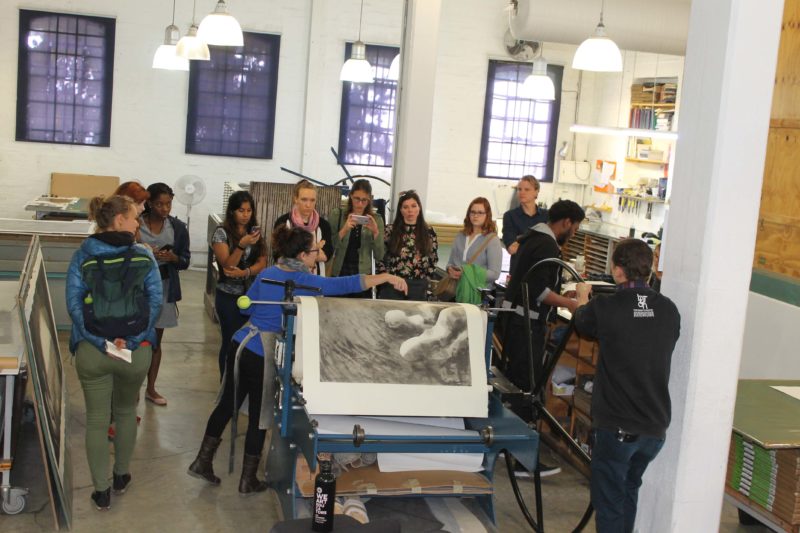
The David Krut Workshop is a collaborative printmaking studio where selected artists work with master printer Jillian Ross and her team of printers to make fine art prints. The David Krut Projects Cape Town Team have their annul visit to Johannesburg in July to join in and learn more from the David Krut Workshop’s activities.
The visit to the workshop acts as an opportunity for the CT Gallery team to recap on printmaking knowledge and familiarise ourselves with the steps involved in creating a print on paper before it reaches the gallery to be shared and appreciated with the public.
 Visiting the workshop is exciting and informative. The workshop is a place where there is constant activity, where a range of prints are at various stages of their production; because of this one can spend hours simply observing and learning from those production stages. You’ll notice the printmakers fully immerse themselves in the task at hand whether it includes tearing paper, inking up a plate or creating registration for the press. It is this focus that is also echoed in how a printer inks up a plate.
Visiting the workshop is exciting and informative. The workshop is a place where there is constant activity, where a range of prints are at various stages of their production; because of this one can spend hours simply observing and learning from those production stages. You’ll notice the printmakers fully immerse themselves in the task at hand whether it includes tearing paper, inking up a plate or creating registration for the press. It is this focus that is also echoed in how a printer inks up a plate.
It is through the skill and focus of the printers that they are able to ink and wipe up a plate the exact same way for each print to achieve consistent tones, textures and at times multiple layers. What the printers always need to keep in mind is how each step effects the other, by perfecting each set in the printing production, the printer and artist achieves the ideal final print.
While works are in progress the printers will pin the working proofs to the workshop walls to analyse the various steps. An artist like Deborah Bell produces many proofs before achieving the final image, as she keeps reworking lines, tones and textures of the plate. After a session where Bell has reworked a plate the image needs to be printed to properly analyze and see what marks have been made. During this step the plate is also steel faced every time before printing. This is a procedure in which a thin layer of pure iron is electro-deposited onto a copper plate to reinforce the drawn images to preserve the plate during printing.

Hanging on the walls of the workshop you will see working proofs and BATs (bon á tirer – ready to go) of various projects. One of the current projects is William Kentridge’s Mantegna and That which I do not Remember works from the Triumphs and Laments series, which are used as reference for editioning of the works.
In the case of the Triumphs and Laments prints; the 195 by 199cm works hanging on the walls consist of many woodcut blocks of different shapes and sizes, collaged together, and therefore require an intricate template, numbering system and trained eye for all the prints to be cropped and puzzled together.
https://www.youtube.com/watch?v=aMBUU74SbuM&feature=youtu.be
The time, process and care that goes into making quality works on paper is imprinted in the artwork.
Having the opportunity to learn and see how the works come together makes the hanging of the works within the gallery spaces that much more remarkable. You learn to appreciate the printers and artists’ attention to detail and how their collaborative relationship make for a unique approach to the techniques and process every time. It is a dynamic space for team work, experimentation, inventiveness and learning.
The David Krut Workshop is also an open workshop where we encourage the public to explore around the archive, studio and bookstore and ask questions. Be sure to visit the workshop at Arts on Main, 264 Fox Street, Maboneng, Johannesburg where you can experience the rotation of the flywheel first hand.
Written by Gabrielle van der Merwe




